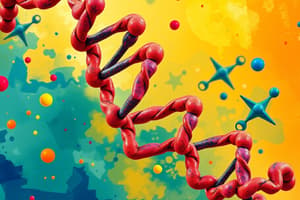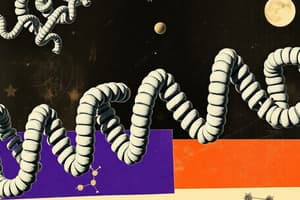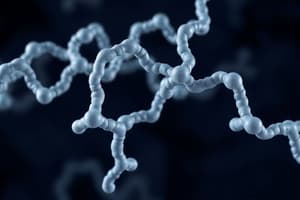Podcast
Questions and Answers
What does a Ramachandran plot visualize?
What does a Ramachandran plot visualize?
- The types of secondary structures present in proteins
- The distribution of amino acids in a protein structure
- Energetically allowed regions for backbone dihedral angles (correct)
- The three-dimensional arrangement of protein chains
The ω angle is defined by the atoms Cα − C' − N − Cα.
The ω angle is defined by the atoms Cα − C' − N − Cα.
True (A)
What is the function of the 'rolling ball' algorithm in calculating solvent accessible areas?
What is the function of the 'rolling ball' algorithm in calculating solvent accessible areas?
To probe the surface of the molecule using a sphere of solvent to measure accessible area.
Proteins with a core of hydrophobic residues and charged atoms stabilized by electrostatic interactions are said to have a ______ structure.
Proteins with a core of hydrophobic residues and charged atoms stabilized by electrostatic interactions are said to have a ______ structure.
Which type of protein is typically characterized as fibrous?
Which type of protein is typically characterized as fibrous?
Match the following types of protein to their description:
Match the following types of protein to their description:
The relative solvent accessible area is calculated using the formula Aobs/Ai.
The relative solvent accessible area is calculated using the formula Aobs/Ai.
What is the general stability in kcal/mole of proteins?
What is the general stability in kcal/mole of proteins?
Which of the following correctly lists the hierarchy of protein structure?
Which of the following correctly lists the hierarchy of protein structure?
Glycine is less flexible than Alanine due to its side chain structure.
Glycine is less flexible than Alanine due to its side chain structure.
What type of bond does Cystine form that is significant in protein structure?
What type of bond does Cystine form that is significant in protein structure?
The equation for the free energy of folding is ∆G = ∆H - T∆______.
The equation for the free energy of folding is ∆G = ∆H - T∆______.
Match the term with its definition:
Match the term with its definition:
What does the L-form indicate about an amino acid residue's chirality?
What does the L-form indicate about an amino acid residue's chirality?
Proline increases the backbone flexibility of proteins more than other amino acids.
Proline increases the backbone flexibility of proteins more than other amino acids.
What primarily drives the folding of proteins?
What primarily drives the folding of proteins?
What interactions do non-polar groups of CH atoms primarily engage in within proteins?
What interactions do non-polar groups of CH atoms primarily engage in within proteins?
Electrostatic interactions are highly favorable in the folded state of proteins.
Electrostatic interactions are highly favorable in the folded state of proteins.
Name one type of repetitive structure found in protein secondary structure.
Name one type of repetitive structure found in protein secondary structure.
The alpha helix is a common type of ___________ in proteins.
The alpha helix is a common type of ___________ in proteins.
What effect does adding non-polar residues have on water molecules in terms of entropy?
What effect does adding non-polar residues have on water molecules in terms of entropy?
Match the type of protein structure with its description:
Match the type of protein structure with its description:
Hydrogen bonds can only form between fully charged side chains.
Hydrogen bonds can only form between fully charged side chains.
What is the result of folding on the degrees of freedom of a protein chain?
What is the result of folding on the degrees of freedom of a protein chain?
Flashcards
Protein Tertiary Structure
Protein Tertiary Structure
The arrangement of amino acid residues in a protein chain, determining its three-dimensional shape.
Protein Quaternary Structure
Protein Quaternary Structure
The arrangement of multiple protein chains (subunits) to form a functional complex.
Dihedral Angle ω (omega)
Dihedral Angle ω (omega)
The dihedral angle between the Cα-C'-N-Cα atoms in a protein chain. It describes the rotation around the peptide bond.
Dihedral Angle φ (Phi)
Dihedral Angle φ (Phi)
Signup and view all the flashcards
Dihedral Angle ψ (Psi)
Dihedral Angle ψ (Psi)
Signup and view all the flashcards
Protein Fold or Topology
Protein Fold or Topology
Signup and view all the flashcards
Solvent Accessible Surface Area (SASA)
Solvent Accessible Surface Area (SASA)
Signup and view all the flashcards
Sidechain Rotamers
Sidechain Rotamers
Signup and view all the flashcards
Protein Primary Structure
Protein Primary Structure
Signup and view all the flashcards
Protein Secondary Structure
Protein Secondary Structure
Signup and view all the flashcards
Chirality of Amino Acid Residue
Chirality of Amino Acid Residue
Signup and view all the flashcards
Ionic Bonds in Protein Structure
Ionic Bonds in Protein Structure
Signup and view all the flashcards
Van der Waals Interactions in Protein Structure
Van der Waals Interactions in Protein Structure
Signup and view all the flashcards
Hydrogen Bond in Protein Structure
Hydrogen Bond in Protein Structure
Signup and view all the flashcards
Hydrophobic Effect
Hydrophobic Effect
Signup and view all the flashcards
Electrostatic Interactions
Electrostatic Interactions
Signup and view all the flashcards
Energetics of Electrostatic Effects
Energetics of Electrostatic Effects
Signup and view all the flashcards
Entropic Effect
Entropic Effect
Signup and view all the flashcards
Secondary Structure
Secondary Structure
Signup and view all the flashcards
Alpha Helix
Alpha Helix
Signup and view all the flashcards
Beta Strand Sheet
Beta Strand Sheet
Signup and view all the flashcards
Beta Turn
Beta Turn
Signup and view all the flashcards
Study Notes
Protein Structure
- Proteins have a hierarchy of structure: primary, secondary, tertiary, and quaternary
- The primary structure is the amino acid sequence
- Secondary structure includes alpha-helices and beta-sheets, stabilized by hydrogen bonds
- Tertiary structure is the overall 3D shape of a polypeptide chain
- Quaternary structure describes the arrangement of multiple polypeptide chains in a protein complex
- The protein backbone is formed by repeating units of amino acids
- Amino acid residues have chiral centers (Ca)
- L-amino acids have the same handedness as the chiral center Cα as CO-R-N clockwise.
- L-amino acids are the common amino acids in proteins
- Some amino acids (like Glycine) have more flexible side chains than others (like Alanine)
- Properties of the amino acid side chains influence protein structure and function
- Non-bonded interactions are crucial for stabilizing protein structure: ionic bonds, hydrogen bonds, and van der Waals interactions.
Protein Folding
- Thermodynamics of protein folding: Gibbs free energy (ΔG) = enthalpy (ΔH) – temperature (T) × entropy (ΔS)
- Protein folding is energetically favorable.
- Hydrophobic effect is crucial, hydrophobic groups tend to cluster in the interior of a protein
- Electrostatic interactions also stabilize protein structure.
- Proteins fold to minimize exposure of hydrophobic portions to water
Protein Secondary Structures
- Alpha helices are a common secondary structure, often stabilized by hydrogen bonds within the polypeptide backbone
- Beta sheets are another common secondary structure composed of beta strands; stabilized by hydrogen bonds between different strands
- Beta terms are non-repetitive, non-local structures, that cause a change in direction of the peptide chain
Protein Tertiary Structure
- Definition: The overall 3D structure of a single polypeptide chain
- Determined by interactions between amino acid side chains
- Interactions include: disulfide bonds, hydrophobic interactions, hydrogen bonds, and electrostatic interactions
Protein Quaternary Structure
- Definition: The arrangement of multiple polypeptide chains in a protein complex
- Formed by interactions between different polypeptide chains
Protein Domains
- Protein domains are distinct structural units in a protein, often with separate functions.
- Protein domains can be classified according to their fold.
- Domains may have evolved from a common ancestor.
Conservation and Variation in Homologous Proteins
- Homologous proteins have similar structure and function, evolved from a common ancestor.
- Sequence and structural conservation of proteins is highest at the active site.
- Functional residues are often highly conserved.
- Variation is often found in the loops and connecting regions between secondary structure elements
Secondary Databases
- SCOP
- SCOPe
- CATH
- SCOP2
Protein Data Bank (PDB)
- PDB is a primary database of protein structures
- It contains a large collection of experimentally determined protein structures.
Studying That Suits You
Use AI to generate personalized quizzes and flashcards to suit your learning preferences.




